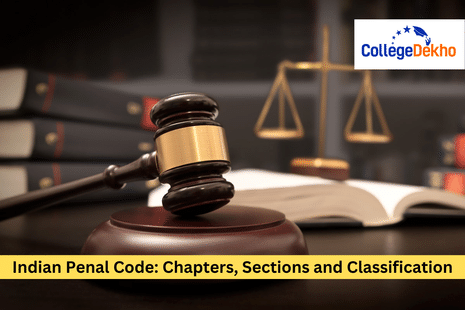This article provides the details of the Indian Penal Code. Law aspiring candidates can read this piece to get knowledge about the Indian Penal Code Chapters, Sections and Classification.

The Indian Penal Code or the IPC was established in 1860 during British rule. The code was effective from January 1, 1862, and applied to India except the princely states. After the Independence, The Government of India adopted IPC as India's official criminal code. This code is applied to Indian citizens and defines crimes and provides punishments for almost all kinds of criminal wrongs. The IPC sections and chapters have been introduced for distinct crimes. The Indian Penal Code Chapters, Sections and Classification will help individuals who are aspiring to enter into the law field and wondering how to become lawyers .
There has been a change in one of the codes of IPC. On August 11, 2023, the Bharatiya Nagarik Suraksha Sanhita, 2023, was presented in the Lok Sabha and it replaces the Code of Criminal Procedure, 1973. This code, however, outlines prosecution, arrest and bail processes for offences under various acts, including the Indian Penal Code, of 1860.
This article contains the Indian Penal Code Chapters, Sections and Classification that law aspirants should have an idea about. The IPC sections list has been provided here so that aspirants can go through and understand the classification.
History of the Indian Penal Code
The Indian Penal Code originated during the British rule in India and it was drafted by the East India Company. Before drafting the Indian Penal Code, the Mohammedan law was in effect in India and the Mohammedan criminal law was applied to both Hindus and Muslims. The initial Indian Penal Code draft was prepared by the First Law Commission, chaired by Thomas Babington Macaulay. The draft was, however, based on the simple codification of the law of England and borrowed elements from the Napoleonic Code and Louisiana Civil Code of 1825. The first draft of IPC was introduced before the Governor General in 1837. Necessary amendments and revisions had to be made which took two more decades. The entire draft of the Indian Penal Code was completed in 1850 and presented before the Legislative Council in 1856. It was still delayed due to the Indian Revolt of 1857. The Indian Penal Code came into action on January 1, 1860, after it went through revisions and amendments by Barnes Peacock who would go on to serve as the first Chief Justice of the Calcutta High Court. By going through the Indian Penal Code Chapters, Sections and Classification, the history will be clear.
Structure of the Indian Penal Code
There are 511 and 23 sections and chapters in the Indian Penal Code respectively. Find here the Indian Penal Code Chapters, Sections and Classification in detail:
Chapter | Sections | Classification |
|---|---|---|
Chapter I | Sections 1 to 5 | Introduction |
Chapter II | Sections 6 to 52 | General Explanations |
Chapter III | Sections 53 to 75 | Of Punishments |
Chapter IV | Sections 76 to 106 | General Exceptions of the Right of Private Defence (Sections 96 to 106) |
Chapter V | Sections 107 to 120 | Of Abetment |
Chapter VA | Sections 120A to 120B | Criminal Conspiracy |
Chapter VI | Sections 121 to 130 | Of Offences against the State |
Chapter VII | Sections 131 to 140 | Of Offences relating to the Army, Navy, and Air Force |
Chapter VIII | Sections 141 to 160 | Of Offences against the Public Tranquillity |
Chapter IX | Sections 161 to 171 | Of Offences by or relating to Public Servants |
Chapter IXA | Sections 171A to 171I | Of Offences Relating to Elections |
Chapter X | Sections 172 to 190 | Of Contempts of Lawful Authority of Public Servants |
Chapter XI | Sections 191 to 229 | Of False Evidence and Offences against Public Justice |
Chapter XII | Sections 230 to 263 | Of Offences relating to coin and Government Stamps |
Chapter XIII | Sections 264 to 267 | Of Offences relating to Weight and Measures |
Chapter XIV | Sections 268 to 294 | Of Offences Affecting the Public Health, Safety, Convenience, Decency and Morals |
Chapter XV | Sections 295 to 298 | Of Offences Relating to Religion |
Chapter XVI | Sections 299 to 377 | Of Offences Affecting the Human Body
|
Chapter XVII | Sections 378 to 462 | Of Offences Against Property
|
Chapter XVIII | Section 463 to 489E | Offences relating to Documents and Property Marks
|
Chapter XIX | Sections 490 to 492 | Of the Criminal Breach of Contracts of Service |
Chapter XX | Sections 493 to 498 | Of Offences Related to Marriage |
Chapter XXA | Sections 498A | Of Cruelty by Husband or Relatives of Husband |
Chapter XXI | Sections 499 to 502 | Of Defamation |
Chapter XXII | Sections 503 to 510 | Of Criminal intimidation, Insult, and Annoyance |
Chapter XXIII | Section 511 | Of Attempts to Commit Offences |
Significance of the Indian Penal Code
A single legislature for the entire country was established by the Charter Act of 1833 to achieve uniformity of laws and judicial procedures throughout British India. The Indian Penal Code Chapters, Sections and Classification have some significance that aspiring law candidates should be aware of. The importance of the Indian Penal Code (IPC) has been provided here:
- It is the main criminal code of India and the individual offence has been well defined, providing all of the required details.
- The code defines the crime and the punishments for committing such a crime.
- IPC serves as a reference guide for the decision-making rules and punishment in cases of fraudulent activity or misconduct.
- This document focuses on all of the major offences that are prevalent in society.
- It contains relevant criminal violations dealing with crimes against the state, public offences, armed forces offences, kidnapping, rape, murder, etc.
- The code covers offences related to religion and property, marriage offences, cruelty from husbands or relatives, defamation, and many more.
- The introduction chapter of IPC states that the provisions of the Penal Code apply to offences committed by an Indian citizen living outside or beyond India and a person on any ship or aircraft registered in India, regardless of location.
- There are 5 types of punishments in the IPC (Sections 53 to 75 of the IPC in Chapter III): death, life imprisonment, general imprisonment, forfeiture of property, and fine.
- Apart from the criminal laws of the Indian Penal Code of 1860, the Central and State Legislations have passed several laws that are a part of India’s penal code to address particular issues such as the Information Technology Act, Narcotics and Psychotropic Substances Act, Prevention of Corruption Act and the Indecent Representation of Women Act, etc.
Fundamental Rights of the Constitution of India
Discussed above are the Indian Penal Code Chapters, Sections and Classification which are important for law aspirants. Fundamental rights of the Indian constitution are the basic rights provided by the constitution to the citizens of India. The 6 Fundamental Rights of the Constitution of India are the Right to Equality, the Right to freedom, the Right against exploitation, the Right to freedom of Religion, Cultural and Educational Rights and the Right to Constitutional Remedies.
Right to Equality: Article 14 to Article 18
- Article 14 - Equality before the law
- Article 15 - Prohibition of discrimination of individuals on the grounds of religion, race, caste, sex, place of birth
- Article 16 - Equality of opportunity to individuals in matters of public employment
- Article 17 - Abolition of untouchability
- Article 18 - Abolition of titles
Right to Freedom: Article 19 to Article 22
- Six rights are guaranteed to all the citizens in Article 19 of the Constitution of India.
- Right to freedom of speech and expression.
- Right to assemble peacefully and without arms.
- Right to form associations or unions.
- Right to move freely throughout the territory of India.
- Right to reside and settle in any part of the territory of India.
- Right to practice any profession or to carry on any occupation, trade, and business.
- Article 20 - Protection in respect of conviction for offences.
- Article 21 - Protection of life and personal liberty.
- Article 21A - Right to education
- Article 22 - Protection against arrest and detention in certain cases.
Right Against Exploitation: Article 23 and Article 24
- Article 23 - Prohibition of traffic in human beings and forced labour.
- Article 24 - Prohibition of employment of children in factories and mines under the age of 14.
Right to Freedom of Religion: Article 25 to Article 28
- Article 25 - Freedom of conscience and free profession, practice and propagation of religion.
- Article 26 - Freedom to manage religious affairs.
- Article 27- Freedom to pay taxes for the promotion of any particular religion.
- Article 28 - Freedom from attending religious instruction.
Cultural and Educational Rights: Article 29 and Article 30
- Article 29 - Protection of interest of minorities.
- Article 30 - Right of minorities to establish and administer educational institutions.
- Article 32 - Remedies for enforcement of Fundamental Rights.
Also Read: Corporate Lawyer Vs Practising Lawyer - Which is Better?
Criticism Related to Indian Penal Code
The Indian Penal Code was introduced by the British Government in 1860 which means it is a 164-year official criminal code of India. The code was, however, not completely amended since it was introduced. Indian Penal Code Chapters, Sections and Classification have some objections as well. Some of the major criticisms related to the Indian Penal Code are:
- Some of the sections of the Indian Penal Code like Section 153A, Section 153B, Section 295A and Section 505 promote enmity in society which is a criminal offence. The criticisms towards these sections are increasing as they are misused for creative, literary, and educational work.
- The use and misuse of Sedition Law (Section 124A of the Indian Penal Code) is from the colonial era, which is not fit for today’s Indian democracy.
- The argument for abolishing Section 295A, which was added to the law in 1927, is that blasphemy is a crime that has no place in the Indian liberal democracy.
- Another criticism of the Indian Penal Code is the similarity of Section 149 IPC (unlawful assembly) with Fundamental Rights.
- Furthermore, there are other serious offences listed in the Indian Penal Code that do not have appropriate punishments, resulting in injustice.
Stay tuned to CollegeDekho for more information regarding top law colleges in India . If you are interested in knowing about the Indian Penal Code Chapters, Sections and Classification, then fill out the Common Application Form . Students who have any queries and doubts can write to us on our QnA Zone where their problems are solved by our experts.

















Similar Articles
Government Colleges in Maharashtra accepting MH CET Law 2024
How to Prepare for CLAT 2025 Without Coaching?
CLAT 2025 Question Paper Format: Check Section Wise Tentative Number of Questions
CLAT 2025 Important Topics & Subject Wise Weightage
How to Crack CLAT 2025 in First Attempt?
Common Mistakes to Avoid on CLAT 2025 Exam Day